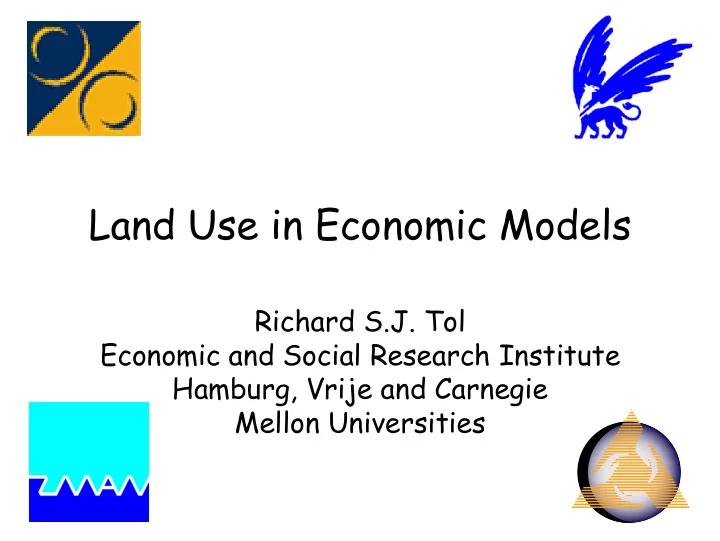

Land Use in Economic Models Richard S.J. Tol Economic and Social Research Institute Hamburg, Vrije and Carnegie ����� Mellon Universities ����� ����� ����� �����
Classics • Economics started as management of large farms – agriculture and land dominated • The Physiocrats believed that land is the true source of value (cf. Wackernagel) • The Classical economists were also much into land and agriculture – Decreasing RTS: Farmhands on a field – Externalities: Beekeeper and farmer – Ricardo still makes the AER • Von Thuenen’s concentric circles, Zipf’s Law for city sizes, Christaller’s lattice ����� ����� ����� ����� �����
Modern Times • Later, land use was relegated to subdisciplines • Partly, this is because land is really important only in agriculture, and agriculture is not really important anymore • Krugman (OREP, 1998) offers another reason: Before 1977 we were too dumb • Without congestion, we would all live in the same place • Without agglomeration benefits, we would be spread evenly over the world ����� ����� ����� ����� �����
New Economics • Since 1991, much progress has been made in new economic geography • Cities exist! • From the same roots, new international economics emerged • Rossi-Hansberg (AER, 2005) merged the two, and shows that tariffs and transport costs are very different things • However, nice theory, but little application ����� ����� ����� ����� �����
Modelled and observed cities in Europe Sea transport and altitude are the only exogenous variables Source: Stelder, J. Reg. Sci., 2005
New Economics • Since Krugman (JPE, 1991), much progress has been made in new economic geography • Cities exist! • From the same roots, new international economics emerged • Rossi-Hansberg (AER, 2005) merged the two, and shows that tariffs and transport costs are very different things • However, nice theory, but little application, partly because of lack of data ����� ����� ����� ����� �����
Gross Cell Product Source: Nordhaus, PNAS, 2006
Bioeconomics • There are other developments too • Plants and animals are increasingly modelled as net energy minimisers • Some vegetation models are solved as a Nash equilibrium • Tschirhart (J Theo Biol, 2000) has developed general equilibrium models of ecosystems, with Homo Sapiens as the top predator • Eichner and Pethig (JEEM, 2006) extended this to land use – and get the island hypothesis as a result • Still few applications ����� ����� ����� ����� �����
Land Use and EMF22 • What does this all imply for the down-to- earth, pre-1977 modellers at EMF? • In the long run, our models are all obsolete • For now, we can be useful • For those who rely on GTAP, land has always been there as an endowment • With bio-energy and sequestration, we need to take a harder look at land, and particularly competition for land by food production, energy production, and carbon sequestration • New data allow us to do this! ����� ����� ����� ����� �����
Land Use Issues • Intensive v extensive margin • Physical v economic units • Spot v forward markets • Other demands for land • Externalities • All of this can be done with standard tools and new data – plus creativity and hard work • It does not require a drastic overhaul of the model, and it does not require a 2D representation of land use! ����� ����� ����� ����� �����
Land Use in IAMs • A spatial representation of land use is not necessary to understand food and energy production and sequestration • It is necessary, however, if you want to understand nature – Biodiversity – Eutrophication – Albedo – Soil carbon • New uncertainties will be introduced ����� ����� ����� ����� �����
Tol, in prep.
Land Use in IAMs (2) • There are various ways to include spatially explicit land use – Nest a rule-based model (FARM, IMAGE) – Nest a micro model (AgLU, IFPRI, FARM) – Nest an optimisation model (a la MERGE, FASOM-Macro) – Nest a spatial equilibrium model (…) – Build a new trade / new economic geography model with multiple species • Current work will reveal the strengths and weaknesses ����� ����� ����� ����� �����
Conclusions • There is a new body of theoretical literature emerging that will totally alter the way we model land use • Not now, though • For a number of applications, land use would be overkill – land supply is enough • For other applications, land use is essential – with new challenges for theorists and practioneers alike ����� ����� ����� ����� �����
A Pioneer • Roy Darwin pioneered land use in a CGE – however, if you take a close look at FARM, then they just had six land endowments rather than one, and the six only differed in productivity • The land endowments were the sum from a GIS, but that was just input • The spatial patterns in the GIS had nothing to do the CGE – only the totals matched • GTAP-AEZ follows this, but with much superior data and better production functions ����� ����� ����� ����� �����
Recommend
More recommend